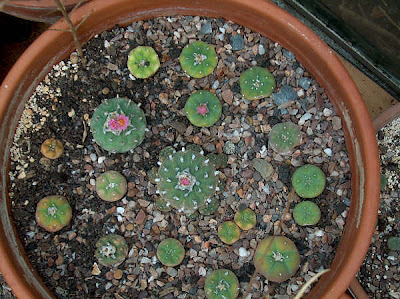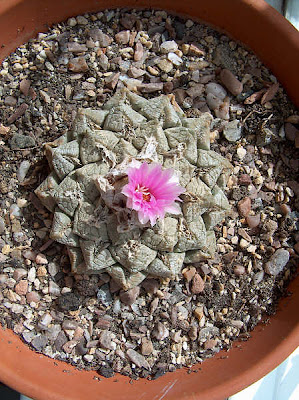I'm sad to say that I have neglected this plant in more than one respect. First I forgot to post on its 5th “grafting anniversary” (this post is almost 5 months due), secondly I didn't check up on it all summer even though it had recently been under attack by red spider mites.

Lophophora williamsii v. caespitosa grafted on Trichocereus stock
As is evident from the pictures I didn't manage to get the mites fully under control before leaving the plant unattended for most of the hot summer months, during which the mites prospered and had a feast on the poor cactus.

Severe spider mite damage
I'm controlling the mites using neem oil, soap, and regular showers – I have considered miticides but am convinced that Darwinistic selection forces will kick in, leaving me with a population of miticide resistant spider mites in the windowsill ;-) I read somewhere that sulfur mixed in with the topsoil repels mites so I might try that (the less aesthetically pleasing solution is to dust the plants with sulfur). Hydrogen peroxide is also said to kill off mites so I still have a couple of options to try out before opting for the harsher chemicals.
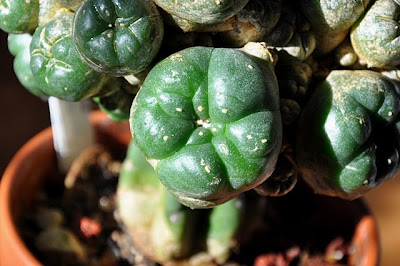
Relatively undamaged button
Large areas of the grafted Lophophora williamsii v. caespitosa are still relatively unaffected by the mites so I'm sure it will grow back given time. I'm a bit puzzled, though, why this particular plant is so popular with the mites compared to most other plants in my collection.

Top view of grafted Lophophora williamsii v. caespitosa
For comparison you can check the posts on the same plant one, two, three, and four years ago.
Tuesday, November 03, 2009
Lophophora williamsii v. caespitosa graft – 5th anniversary
Sunday, June 15, 2008
Lophophora williamsii v. caespitosa graft – 4th anniversary
June 7 my grafted Lophophora williamsii v. caespitosa plant could celebrate its 4th anniversary on top of its Trichocereus bridgesii stock. After four years the main head has grown to a width of 6 cm (~2.4'') and the scion is more than 14 cm (>5.5'') wide in total.

Lophophora williamsii v. caespitosa grafted on Trichocereus stock
Unfortunately the plant was maimed by spider mites last year. I didn't check my plants for mites before leaving them unattended for several weeks during my summer holiday. When I returned the damage was done and much of the plant ended up severely scarred.

Spider mite damage with new growth
Fortunately the spider mites stayed off most of my other plants, and the scarred epidermis of the grafted Lophophora williamsii v. caespitosa will soon be replaced by new growth.
To avoid spider mites I'm now showering my plants as often as the weather and my patience permit ;-) Any remaining mites are sprayed with isopropyl alcohol on sight. So far this treatment has kept my plants safe from mites, but the big test will be the coming hot summer months where the plants are left on their own to a great extent.

Lophophora caespitosa scarred by spider mites
As always I’m fascinated with the explosive growth induced by the Trichocereus stock – for comparison you can check the posts on the same plant one, two, and three years ago.
Wednesday, July 04, 2007
Rory’s Lophophora collection
Some time ago Rory contacted me to discuss cacti and mycorrhizal associations (an interesting subject that might be brought up in a later post). During our conversations Rory revealed himself as an avid Lophophora grower with an impressive collection of mature and well-grown plants. Rory has kindly allowed me to share some pictures of his plants.
Flowering Lophophora williamsii, close-up
Large pot of Lophophora williamsii
The largest of the L. williamsii plants in this pot are approximately 25 years old. One of the plants in the central group (a bit above and to the left of the center) has been decapitated and set 4 offshoots. One of these has not yet developed a central growing point and appears somewhat cristate, but Rory expects it to develop as normal with time. The removed top was rooted and is also growing in the central group of plants (slightly below center; wool removed from areoles), and is flowering regularly.
Large pot of Lophophora fricii
According to Rory the compost used for the L. fricii plants are not drying fast enough. Consequently the plants are kept on the dry side which accounts for the red coloration shown by some of them. The largest of the plants (with a total of 9 offsets) has only grown 1cm (~0.4'') in the past 9 years so Rory is planning on repotting the plants in a new mix and expects this to speed up growth.
Lophophora diffusa about to flower
The above L. echinata diffusa plant is just about to flower - unfortunately it’s too overcast for the flowers to open properly.
Large pot of Lophophora williamsii v .caespitosa
To top things off (or just to make me completely envious ;-) Rory also threw in a photo of a nice, mature Ariocarpus fissuratus specimen.
Flowering Ariocarpus fissuratus
I hope you enjoyed this “guest appearance” - I for one would like to see more of Rory’s plants. If you have pictures or information you would like to share, you can drop me a mail at “lophophora [dot] blog [at] gmail [dot] com”.
Monday, June 25, 2007
Lophophora williamsii v. caespitosa graft
I’ve been pretty busy lately and completely forgot to post on the 3rd anniversary (June 7) of my Lophophora williamsii v. caespitosa graft. The main head is 5.5 cm (~2.2'') wide and the total width of the scion has increased to approximately 13 cm (~5.1'').

Lophophora williamsii v. caespitosa graft
The Lophophora williamsii v. caespitosa scion is grafted on a Trichocereus bridgesii stock and was repotted early this spring (hence the supporting props).

Lophophora williamsii v. caespitosa graft - top view
I’m fascinated by the explosive growth induced by the Trichocereus stock (for comparison you can check the posts on the same plant one and two years ago) but the appearance of the plant tends to become increasingly freakish.
The plant doesn’t bloom with the same vigor as it grows – until now it’s only flowered once.
Saturday, September 30, 2006
Lophophora williamsii – autumn flowers
Having passed the autumnal equinox I hadn’t expected any more flowers from my lophs – nevertheless two of them decided to bloom this week, one for the first time.
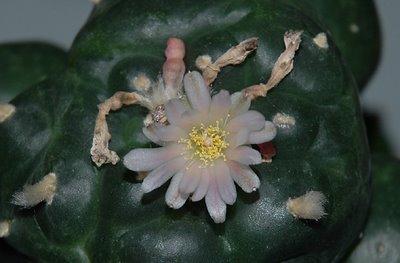
Lophophora williamsii (SB 854; Starr Co, Tx) flower
My grafted Lophophora williamsii (SB 854; Starr Co, Tx) has been flowering abundantly all summer. Several fruits have already ripened and more are budding; still the plant took the opportunity to squeeze in yet another flower before going dormant. The flowers of this plant are quite large, approximately 2.75cm (~1.1'') in diameter.

Lophophora williamsii var. caespitosa flower
The Lophophora williamsii var. caespitosa graft has been growing profusely but never felt like flowering before now. The flowers are small, less than 2cm (~0.8'') in diameter, compared to those of L. williamsii (SB 854; Starr Co, Tx), and the midstripes are a slightly darker shade of pink.

Lophophora williamsii var. caespitosa
The scion used for this graft was taken from the plant shown in the blog profile. Unfortunately this plant later caught rot and died.
Wednesday, June 07, 2006
Lophophora williamsii v. caespitosa graft
Two years ago I grafted a 2 cm (~0.8'') wide Lophophora williamsii v. caespitosa cutting on a Trichocereus bridgesii stock. The main head has now grown to a width of 5.5 cm (~2.2'') and the total width of the scion exceeds 10.5 cm (~4.1'') – unfortunately the plant hasn’t flowered yet.
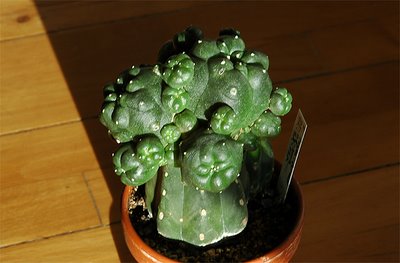
Grafted Lophophora williamsii v. caespitosa
I’ve given up keeping count of the number of offshoots; the plant is virtually exploding with growth.
Trichocereus bridgesii is an exemplary stock plant; it’s long-lived, fast growing, not offsetting and almost spineless.
Last year I also posted a picture of the – then much smaller – Lophophora williamsii v. caespitosa graft. A photo of the flowering plant can be found in this post.
Wednesday, January 18, 2006
Variegated and cristate Lophophora
Many Thai nurseries are offering large selections of variegated and crested cacti. Unfortunately the Lophophora plants are quickly sold out so I haven’t obtained any yet. The photos below are courtesy of Deaw Cactus.
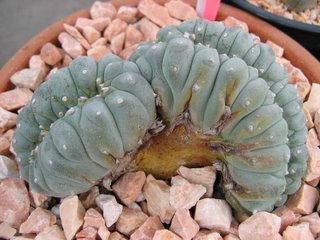
Lophophora williamsii crest (own root) – 13cm
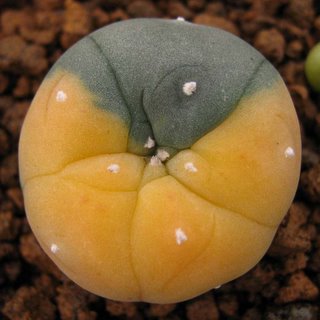
Variegated Lophophora williamsii – 3.5cm
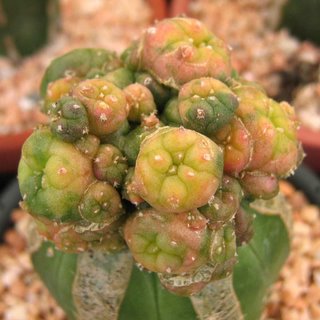
Variegated Lophophora williamsii v. caespitosa – 6cm
Tuesday, December 27, 2005
Lophophora williamsii v. caespitosa
I’m impressed. I found this photo of a humongous Lophophora williamsii v. caespitosa on the British Cactus and Succulent Society discussion forum.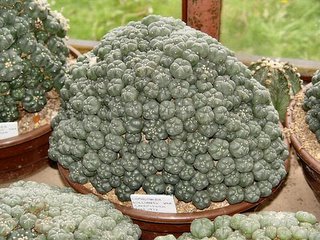
Lophophora williamsii v. caespitosa
According to the forum this amazing plant was sown back in 1972, and is just one of a batch. Unfortunately it doesn’t say when the picture was taken.
Tuesday, June 07, 2005
Exploding Lophophora Inevitable
The main head of my grafted Lophophora williamsii v. caespitosa is now 4.5 cm (~1.77’’) wide – the total width of the scion is 7.3 cm (~2.87’’). The plant was grafted one year ago as a 2 cm (~0.78’’) wide cutting taken from the plant shown in my profile photo. Unfortunately the mother plant caught rot in the wound and withered during winter. The scion is grafted on a Trichocereus bridgesii (Echinopsis lageniformis) stock.
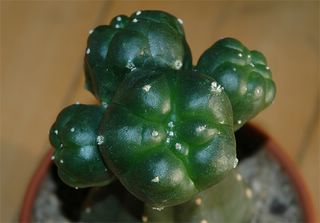
Grafted Lophophora williamsii v. caespitosa
Maybe the Andy Warhol/Velvet Underground inspired title is a bit corny – but it seemed fitting for a plant exploding with growth ;-)
Follow this link to see the state of the Lophophora williamsii v. caespitosa graft one year later.
All Time Most Popular Posts
-
Lophophora williamsii (peyote) populations have diminished in large areas of South Texas where peyoteros harvest the cactus for ceremonial ...
-
On various occasions I've been asked what growing media I'm using for my cactus plants. I don't have a set soil mix recipe as su...
-
Below is a list of retailers/nurseries selling cactus seed and plants. I've only listed vendors I've done business with. If you ar...
-
Most cacti are easily grown from seed - and with a little patience and care they can be grown into beautiful plants. Lophophora williamsi...
-
In last month’s post on the troubled Texan peyoteros I referred to Anderson’s article on the peyote situation in Texas. Given the importanc...
-
Yet another slightly off topic and probably not entirely politically correct post, but I couldn’t help noticing the similarity of my monstr...
-
Flowering stand of San Pedro cacti (Trichocereus pachanoi) To me the main draw of the San Pedro cactus ( Trichocereus pachanoi (syn. Ech...
-
In the June 2008 issue of the Cactus & Co magazine Jaroslav Šnicer, Jaroslav Bohata, and Vojtěch Myšák described a new Lophophora spec...
-
There seems to be an increased focus on the alarming Texas peyote situation. A couple of weeks ago the Houston Press published a mournful, i...
-
I spent two weeks working in Delhi, India during January. I had one weekend off and had planned to spend it in Delhi at my own leisure, but ...


